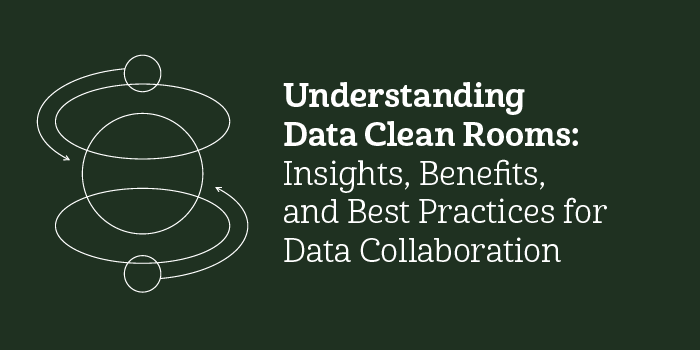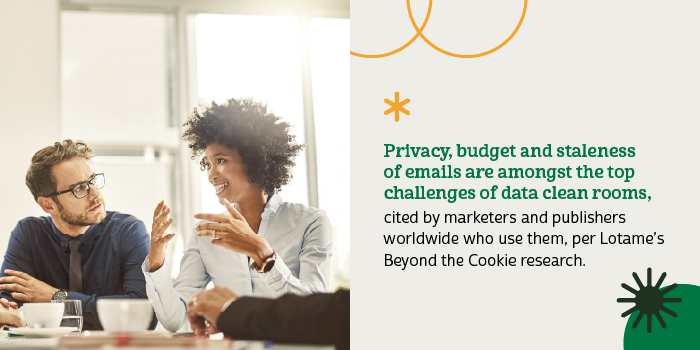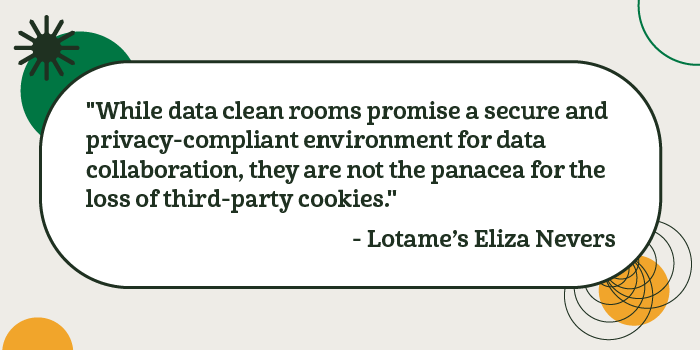
Data has been termed the ‘new oil’ of the digital age, but it is more than that. It’s the lifeblood of modern businesses, and its efficacy is dependent on how it’s refined, shared, and utilized. But as data privacy regulations tighten around the world, it’s getting harder and harder to tap into the full potential data can offer without compromising security. Enter the world of data clean rooms and data collaboration.
At Lotame, we are always at the forefront of next-generation data solutions, and in this piece, we take a deep dive into the realms of data clean rooms, their significance, and how they’re reshaping the digital advertising landscape.
What Exactly is a Data Clean Room?
A data clean room serves as a secure environment where companies can analyze two separate data sets without directly accessing it. Instead of merging raw data sets, different entities can derive collective insights from their data without any risk of revealing personal data or proprietary information.
Here’s an analogy from our friends at U of Digital that might help clear things up:
Think of a company hiring a contractor to examine employee data. The contractor isn’t allowed to view individual records. Instead, an HR representative, acting like a data clean room, accesses and relays the needed information. For instance, for an average salary query by city, the HR provides the answer. This ensures sensitive data remains untouched while delivering essential insights.
Why Is Data Collaboration So Important?
Data clean rooms pave the way for secure data collaboration. In the world of marketing, two heads (or data sets) are always better than one. Data clean rooms unlock potential that isolated data sets can never achieve.
Why is this collaboration imperative now? Here’s a breakdown:
- Heightened Need for Security: As privacy and data security become a huge focus in the market, collaboration environments can reveal valuable data insights without compromising individual data privacy or revealing proprietary information.
- Loss of Third-Party Cookies: As the digital advertising ecosystem enters the post-cookie era, advertisers and publishers are looking for alternative ways to enhance their first-party data, leading to more collaborative data sharing strategies.
- Increasingly Demanding Consumers: As technology advances, customers demand better experiences and will easily switch brands if disappointed. To retain loyalty, companies must use data-driven strategies to understand customer needs and offer personalized services. Clean rooms help make data informed decisions, such as informing more likely areas to find your next best customer
Understanding The Different Types of Data Clean Rooms
Data clean rooms are a data collaboration tool that have generated a lot of hype in the industry. But not all are created equal, with several different flavors on the market. Understanding the different types of data clean rooms and their strengths and weaknesses, can help you decide which data collaboration tool is right for your business.
Here are the four main types of data clean rooms.
1. Data Warehouses
Platforms primarily acting as data warehouses or clouds often incorporate clean room capabilities. The stored data in these warehouses can be privately transferred into the clean room for collaboration, particularly for attribution and measurement. Tailored solutions can be designed on these platforms, given that the participating enterprise possesses robust engineering and data science resources.
2. Walled Gardens
A Walled Garden clean room operates within a closed ecosystem. These are often created and managed by major tech companies such as Google and Facebook. Within these walled gardens, marketers have the opportunity to merge their proprietary first-party data with the consumer data that resides exclusively within the confines of the clean room environment provided by the walled garden. This setup ensures data privacy by limiting the data’s movement outside the specific environment, but it also gives these big tech players significant control over data access and use.
3. Data Collaboration
In these platforms, marketers import their data, merging it with a common identifier, which could be anything from hashed emails and mobile ad identifiers to Universal IDs, underpinned by an identity backbone. This enables a private, secure collaborative environment. These platforms excel in data analysis, enrichment, modeling, and activation. Unlike walled garden clean rooms that only function within their own ecosystem, data collaborations offer a more expansive range of utilities. They are designed for marketers looking to derive insights and activate seamlessly.
Lotame’s end-to-end data collaboration platform, Spherical stands out in the data collaboration category by offering a comprehensive suite of services that includes customer intelligence, data-informed audience creation, and identity-powered activation. Our collaboration offering, Lotame Collaborate is also available for a minimal cost versus standing up data in an alternative platform and paying to host there as well.
4. Query
Query clean rooms serve as a neutral territory for entities that wish to cooperate on their first-party datasets with other stakeholders, like a publisher collaborating with a brand. What distinguishes these cleanrooms is the “Non-Movement of Data” feature. Instead of moving and storing the data in a central location, these platforms allow brands and other entities to keep the data within their own environment. Collaborating parties can run queries and analyses without the data ever leaving its original location, ensuring both security and control over the data. Tech savvy marketers, with the right training, could find this tool valuable, but it’s primarily owned by a businesses’ tech team. One of the biggest applications of this type of clean room is discerning overlaps. They accept any common identifier available to both parties, which can limit scale of the outcome.
Data Clean Room Challenges

As with any new technology, data clean rooms have challenges that users should be aware of:
- Scale: Most data clean rooms rely on email or a mobile ad identifier as the join mechanism. But without sufficient scale of those IDs from both participants, match rates may be too low for useful analysis.
- Poor Analysis and Activation: Many data warehouses and query clean rooms don’t offer clear solutions for analysis overlap between data sets or the ability to enrich, model, and extend these audiences beyond emails and known customers.
- Resource Intensive: Organizations need data engineers skilled in data management, querying, security, and analytics to effectively operate and manage most data clean rooms.
- Absence of Standardization: The landscape is dotted with multiple walled garden solutions, leading to a lack of standard procedures or interoperability among different clean room providers, making it challenging to derive a clear picture of what is working and why.
- Costly Participation: Engaging with multiple clean rooms can be a financially daunting task. The costs can mount quickly, making it expensive for entities to leverage the full spectrum of benefits.
In a nutshell, while data clean rooms offer promising solutions in the realm of data collaboration, it’s essential to be aware of the existing shortcomings in the current offerings. It’s also critical to note that data clean rooms are not a comprehensive replacement for third-party cookies. They are simply a tool to be used in a marketer’s diverse tool set.

Selecting The Right Data Clean Room
There’s a lot of industry hype surrounding the data clean room. Not every tool is created equally, and with so many different variations and platforms out there, choosing the right one can feel overwhelming. So here’s a few items to consider across these critical categories:
- Security & Control: First and foremost, any platform should prioritize security and control. Data breaches can not only be costly but can also erode trust.
- Scalability: Does the tool use identifiers other than email, or in addition to email to get the scale you need to power analysis and activation?
- Activation: Consider whether the tool you use has the ability to enrich, model and extend audiences beyond emails and known customers for activation in adtech or madtech platforms.
- User-Friendly Interface: Collaboration is about people. If the tool is too complicated, it hinders the very collaboration it aims to promote.
Use Cases for Data Collaboration & Clean Rooms
Understanding data clean rooms and the importance of data collaboration is just the beginning. The true value of collaboration becomes apparent when we delve into its applications, especially for marketers and media owners.
For Marketers & Agencies: Targeting and Personalization
Marketers have always sought to understand their audiences better, and data collaboration enables just that. Let’s explore how:
- Personalized Marketing: By collaborating with partners, marketers can discover what is driving buying behavior to inform retention and acquisition strategies in a world where addressable marketing is getting more scarce.
- Optimized Marketing Budgets: Discovering insights from various data sources can provide a clearer picture of what strategies are working. This can help in allocating budgets more efficiently.
- Enhanced Product Development: By gaining insights from related partners, marketers can better understand customer needs and preferences, leading to more targeted product developments.
For Media Owners: Refining Content Strategy and Monetization
Media owners and publishers stand to gain significantly from data collaboration:
- Audience Validation: Publishers need to prove the presence of a brand’s existing or prospective customer set to win their advertising budget. With impending signal loss, collaboration platforms stand to replace this capability.
- Ad Monetization: Collaborative insights can inform more targeted ad placements, and content strategies more likely to perform, yielding higher CPMs and better revenue streams.
- Subscription Strategies: Using collaborative data, media owners can personalize content, resulting in increased page views and subscription rates.
Why Data Collaboration Isn’t A Replacement for Cookies
While data collaboration and data clean rooms are a valuable tool in the marketer’s arsenal, they cannot singularly replace third-party cookies. Third-party cookies offered an “easier” way to associate user behavior to the device or domain they were exhibiting it on, and persist that information across sessions and time. Clean rooms rely on first-party data tied to a common identifier, which tends not to connect into activation platforms in a scalable way that could replace what third-party cookies have offered.
Instead, businesses need to adopt a multi-pronged approach, combining the strengths of data clean rooms with other solutions like first-party data management, audience modeling / enrichment, and identity solutions. This comprehensive strategy will ensure that marketers can continue to engage their audiences effectively while respecting user privacy in the post-cookie era.
Data Collaboration with Lotame
Lotame’s end-to-end data collaboration platform Spherical is an all-one-solution for digital marketer, agencies and media owners. We provide identity resolution and onboarding, in addition to standard audience management platform capabilities, such as enrichment and modeling, on top of facilitating data collaborations. Learn more about how we can help you make your data smarter, faster and easier to use with data collaboration. Book a free consultation today!